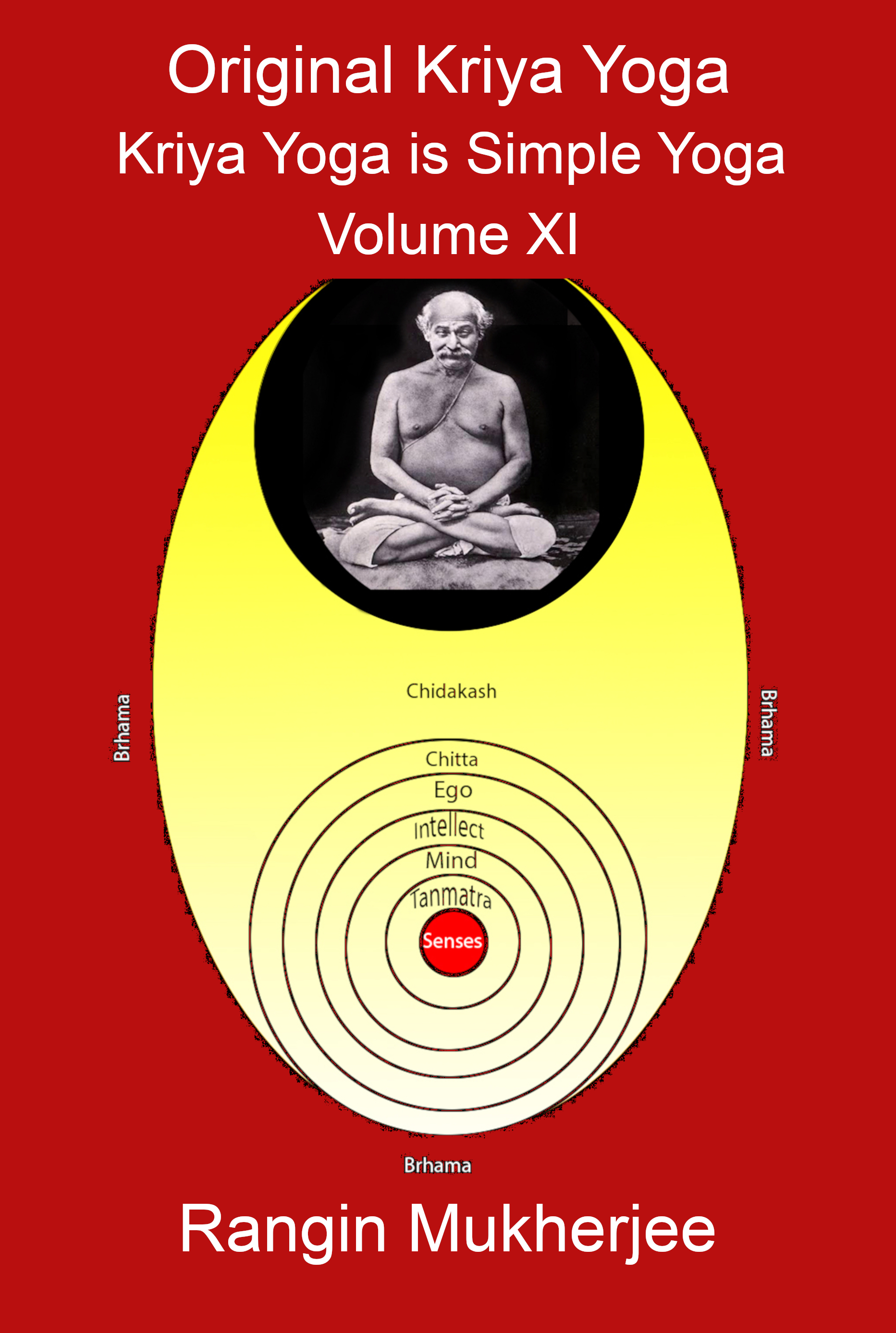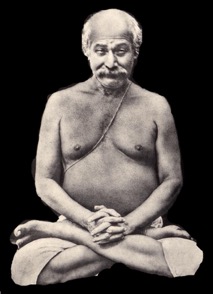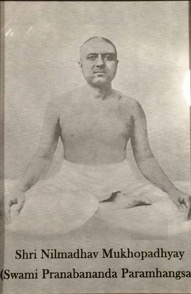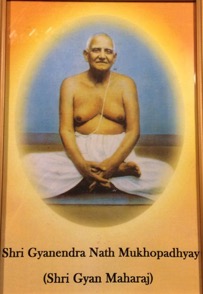If one practices Kriya Yoga following proper procedures, he
or she can rapidly progress in the spiritual path.
Direct perception of inner vision and spiritual feeling will start.
It is very easy to reach the goal. If one practices correctly, he or
she can attain salvation in present birth or by next birth.
But attaining salvation with
Mantra Yoga is a delayed process.
In
Mantra Yoga, one gets direct inner vision and spiritual
feeling very late or one may not even get it. In
Kali Yuga (present
materialistic era is called
Kali Yuga), the life span of human
being is very limited. Hence I feel, practicing
Kriya Yoga is
the best for rapid spiritual progress and for attaining salvation.
Why should we practice Kriya Yoga?
One should practice
Kriya Yoga to be free once for all from the recurring pain of birth and death.
More over everybody is suffering from worldly pain in this limited life span.
On the one hand, God with the help of the veil (
Maya) and attraction toward materialistic
world (
moha: forgetting the nature of true self), has created bondage for human beings to become
imprisoned in this world of birth and death. On the other hand, He has given the way to become free from this.
He has given intellect and logical mind to human beings to decide which way to choose.
If you do not come out of worldly attraction now, when will you do so?
For the sake of momentary joy, man forgets everlasting joy and bliss.
Time and tide wait for no one. So, let us not waste time further, and let
us move towards salvation. The amount of
Kriya done in this present birth will be
stored for the next. The efforts in
Kriya Yoga are never wasted. Otherwise one has to
move empty handed to the unknown and dark world of death.
Lord Sri Krishna uttered the following in
Srimad Bhagavad Gita:
"nehavikramanasti pratyabayo na bidyate salpamapasya dharma trayate mahato vayat" (2:40)
So, a little practice of this
Kriya Yoga, makes one free from the great fear of death.
(Both the states of birth and death are very painful and horrifying.
Before birth, a baby stays in the mother's womb in a very uncomfortable
position. The state of death is further painful, because on one side he feels the pain of
leaving the worldly things and his relations behind.
He succumbs to breath, but cannot breathe. Moreover, after death he enters in
the state of total darkness where he cannot understand his
own condition.) If one practices
Kriya Yoga correctly, and does not attain
salvation in this birth, he will again get
Kriya Yoga in the next birth and
attain very easily the stages achieved in this birth.
Then, he has only to cover the remaining part.
Siddhartha left his kingdom and luxurious life after
seeing the suffering that resulted from aging, illness, death etc.
He submerged himself in deep
Sadhana, thereby
attaining
Nirvana and became Gautama Buddha.
He realised that one day he would face these sufferings,
so he lost all attachment toward worldly pleasures. He
forgot his past and started doing
Yoga Sadhana with new
enthusiasm and zeal.
The state of the mind can be classified into five stages. The first
state of mind is the state of insanity, or state of craziness,
where it fails to understand its own condition or surroundings.
In this state, the mind gets filled with such types of thought
patterns that even the normal mind cannot dream of.
Swami Vivekananda went through this phase and mentioned it in
one of his books.
The second state is the state of total restlessness where it
swings from one worldly object to another. In the third state,
the mind is sometime restless, and also sometimes it tries
to concentrate to remain in a static state. Since in this
stage it also touches the static phase even for a few moments,
Divine realisation starts from this point.
The fourth state of mind is the stage of
concentrated mind where it becomes fixed to a particular
spiritual object or
chakra. The fifth stage of mind
is the stage of
Samadhi where the mind loses its distinct
and independent existence (entity) and merges into total bliss.
Actual spiritual realisation
begins from the third stage, because in this stage mind remains
in the static state for few moments. The state of restless mind
is actual vice, and state of static mind is virtue. Hence
please step towards the static state. Surely you will feel
blessings (
Kripa).
Even the common man can attain the state of a
great
Sadhaka as a result of
Sadhana carried out in
several births and attain the stage of eternal
bliss (
Brahmananda). Hence, we should follow the
path of such great people and practice as advised by them.
But be careful about one thing, when you advance in the
path of Kriya Yoga, whatever spiritual vision or feeling you
obtain, even by mistake, you should never disclose it to anybody
other than your
Guru. Many occult powers (
Vibhuti)
will come to you, but you should not accept those.
[These are described in Chapter-7.]
If you accept these powers, then you will be diverted from the
spiritual path and your further progress will stop on the spiritual path.
All your spiritual
Sadhana will have been in vain.
All these are given by God only. He tests the
Sadhaka
with these to see whether
Sadhaka really
seeks God or occult powers. If you want these occult powers,
you can earn name and fame in society; you will earn lots of
money, too. This will lead to an increase in pride and
arrogance and lead you to the path of ruin. Be careful,
otherwise you will spoil your state before and after death.
So, be careful. Do your
Sadhana behind closed doors.
Nobody should be able to know what you are doing.
One thing should be known to those who are afraid of
ghosts and spirits. When one practices
Kriya, no ghost
or spirit can enter within 500 yards of your circumference. So
if you see or feel anything fearful during
Kriya practice,
perceive it to be spiritual only. You need not be afraid
of spirits or ghosts. Sometime in the beginning, during
Kriya practice it is felt that the room has been
covered with good odour of incense stick, or flower, as felt in
temple. All these things happen as the
Sadhaka enters the
subtle spiritual field.
What is Original Kriya Yoga?
Kriya Yoga, Raja Yoga or Brahma Vidya (study of Brahma) are
all the same. Revered Babaji Maharaja (who is alive still
today and whose age is approximately 500 years) gave this
great Sadhana to his dearest disciple revered
Yogiraj Shyamacharan Lahiri Mahaysaya to show the path
of spiritual enlightenment to the householders of the
present materialistic age. Lord Sri Krishna has given
this Kriya Yoga to his dearest
disciple "Arjuna." The detailed description of this
is explained beautifully by my Gurudeb Shri Shri
Gyanendranath Mukhopadhyay (Gyana Maharaja) in
his Pranab Gita. The book Pranab Gita was
written by my Gurudeb
based on his spiritual enlightenment and on the light of the spiritual
advice from my great Gurudeb Pranabananda Paramhansa.
[Paramhansa Pranabananda was the spiritual successor of Yogiraj
Shyamacharan Lahiri].
There are eight steps in Yoga Sadhana i.e.
controlling of senses (Yama),
strict discipline (Niyama), correct posture (Asana),
control of Life-forces (Pranayam),
withdrawing from outer senses (Pratyahar),
fixing mind to a particular object or thought (Dharana),
diving into deep inside to almost merge into Eternal Truth (Dhyana).
Then Sadhaka merges into the Eternal Truth and becomes the
one (Samadhi).
Though these steps are common in both
Kriya Yoga and Raja Yoga, there are some differences too.
There are some mudras and special techniques included in the
Kriya Yoga for the benefit of Kriya practice - for example
Mahamudra, Khechari Mudra, Yoni Mudra, and
besides these Navi Kriya, first Kriya, second Kriya, third
Kriya, fourth Kriya, Granthi Veda Kriya (Kriya for
piercing the knots),
Ida - pingala sodhan Kriya (Kriya for purification
of Ida and Pingala nadi) etc etc.
From Patravali of Lahiri
Mahasaya (Garland of Letters) we find that he has
written to one of his disciples that "Everything is
achievable with the first kriya. Parabastha and Divine
intoxication, everything is there in first
Kriya." My Guruji also said that one can attain
Samadhi with the first Kriya only.
Nowadays, some people have started doing business in India and the West
in the name of Kriya Yoga (and in the name of "Original
Kriya Yoga", too). To show their superiority over others,
they have added many unnecessary and difficult techniques to this
simple Kriya Yoga. So, I request the readers not to fall into such
business traps.
The first Kriya includes Asana (sitting in
correct posture), Pranayam (Kriya for control of Life-force),
Yonimudra, Mahamudra and Parabastha
(Pratyahar- withdrawal of mind from outer senses).
By practicing this, one reaches the stage of Dharana,
Dhyana and Samadhi. Everything comes automatically.
The only requirement is love towards God, devotion, and practicing
Kriya correctly. This is the original Kriya
given by Yogiraj Shymacharan Lahiri Mahasaya.
Diksha is the most important aspect of sadhana! It is like the second birth of Sadhak
in the spiritual world. Without diksha or initiation from a satguru, the kriyas discussed here
simply holds no power!
Diksha is like a seed, and the daily sadhana of these kriyas is like water.
Both diksha and sadhana work together for spiritual growth of the sadhak.
Initiation is not just the revealing of techniques of kriya. There is more to it. It is the
transfer of the spark of light from one soul to another, and connects the sadhak with the
lineage of Sri Lahiri Baba, Swami Pranabananda Giri, and Sri Gyanendra Nath baba. This transfer
activates the sleeping divine energy inside the sadhak and pushes his/her consciousness
towards a more positive and sattvic state.
Diksha/Initiation is a very secret affair between Guru and disciple! It is never done in masses or public (or online!). It establishes a unbreakable bond between Guru and disciple. Without diksha, sadhana is useless.
The mystery of Kriya Yoga relies on the foundation
of crossing the boundary of mind and intellect by
watching the Life-force (Prana) and merging
the individual spirit (Jivatma) into the Eternal Spirit (Parmatma).
So, first, one has to practice the Kriya using the six energy
centres in the spine (Shat Chakra). Then
one pierces the chakras one by one and at last pierces
the Ajna chakra.
This marks the end of Kriya practice in the six energy centres of the spine.
After that Kriya starts in the field of intellect (Budhi Kshetra) and in
the field of Eternity (Parama Kshetra). All these things happen with
Kriya Yoga. Before writing how Kriya Yoga should be
practiced, it is required to clearly understand the relation between
the Life-force (Prana), mind (Mana),
intellect (Budhhi), individual spirit (Jivatma)
and the eternal spirit (Parmatma).
If inhaling and exhaling becomes frequent and uncontrolled,
the mind becomes restless. On the other hand, if the mind becomes restless,
breathing becomes frequent and uncontrolled. Both mind and breathing are interdependent.
As breathing is gross in nature (sthula in Sanskrit), and mind is subtle (sukshma
in Sanskrit), it is easy to control the breath first because controlling of the gross is easier than
controlling the subtle. That is why it is required to control breathing first with the help
of pranayam. Slowly it will be subtle.
Moreover, the concept of the relation and difference between breathing, Life-force and mind should be clear;
otherwise, it will be confusing. Breathing is controlled by Life-force; however it cannot be termed as
direct Life-force.
The force, or the energy, which helps us to take air inside the body during the in-breath and the outflow
of air from the body during the out-breath is nothing but the Life-force. This Life-force is distributed
all over the body. All the internal organs are controlled by this Life-force. That is why the body
internal organs stop working in the absence of Life-force, and is then declared as a dead body.
Life-force can be compared with electricity which drives the motor (heart in case of human body) and
motor (heart) in turn drives the machine (lungs in human body).
In easy language, it can be explained in the following way: at
first by breath control ( pranayama), breath should be converted from
subtle to extremely subtle. The state of this extreme subtle breathing
is the same as the Life-force. And the state of subtle Life-force
is mind. The state of subtle mind is intellect. The state of subtle
intellect is individual spirit (Jivatma), and the state of
extreme subtle individual spirit is universal spirit (Parmatma).
As the Life-force becomes more and more subtle, the Prana Vayu
(breathing) becomes extreme subtle; it will not flow through
the nose and will move inside body through Sushumna.
In this condition of Kumbhak (*), the Prana or
Life-force moves in Sushumna and mind will slowly
merge into Life-force and they will start moving together.
With this Life-force and mind, it is required to pierce the
six chakras.
After piercing the Ajna chakra, it is
seen that there is no relation between mind and Life-force.
Then mind becomes more subtle, and merges with the intellect
and Kriya starts in the space of intellect. After
completion of Kriya in the space of intellect, it
becomes more subtle and merges into individual spirit (Jivatma).
At that time, it is required to take the individual spirit
into the space of universal eternal spirit (Parmatma)
and merge the Jivatma
with the Parmatma. At the end it is required to pierce the
Mula Chakra and submerge in formless Brahma
(Nirguna Brahma). This is called the stage of Brahmalin.
(*) KUMBHAK: Now I will describe to the readers the science of this subtle breathing. A normal
man breathes 21,600 times in a day or 15 times in a minute (normal condition).
After breathing out, the air covers a distance of the length of 12 fingers from the nostril. If a person can
reduce the distance covered by the outward breathe by 1 finger, it will result in reduction in
rate of breathing by 1.25 times per minute. [For example when the distance covered by
the air of the out-breath is 11 fingers, the rate of breathing will be 13.75 times per minute]. So,
the rate of breathing becomes zero when breath does not come out of nostrils. This is called the
stage of Kumbhak.
The longevity increases by practicing this Kumbhak. A man takes
birth with a fixed number of breaths to be taken during his life span.
(This quota of breath is allocated by the Almighty.) The activities
which increase the rate of breathing are defined as vice in the
scriptures because it reduces the life span; the virtuous activities
are those which make the mind peaceful, and thus reduce the rate of
breathing. As the breathing does not take place during Kumbhak,
it increases the life-span.
The life-span of a normal man in Kali yuga as per scripture is
124 years. It is reduced because of the modern hectic life, pollution,
food habits, and stress. However Kumbhak increases the life
span of a yogi.
As described earlier, there are eight steps common to Kriya Yoga and Raja
Yoga.
They are controlling of senses (Yama), strict discipline (Niyama),
correct posture (Asana), control of Life-force (Pranayam),
withdrawing from outer senses (Pratyahar), fixing mind to a
particular object or thought (Dharana), diving deep inside
to almost merge into the Eternal Truth (Dhyana) and then the Sadhaka and
the Eternal Truth become the one (Samadhi).
The first five steps i.e Yama, Niyama, Asana,
Pranayam Pratyahar
are included in Karma Yoga (Yoga of work).
And Dharana, Dhyana and Samadhi are Kriyas done in the field of
intellect (Buddhi) and divinity (Paramakhetra). So, they are the
Kriyas of devotion and knowledge or Kriyas done in Sahasrar.
YAMA: First important thing is food.
If the food eaten by Sadhaka is not sattvic in nature,
then there is no chance of spiritual improvement.
Because, if the body becomes restless,
mind will also become restless.
The following are the examples of sattvic food (for the
benefit of English readers, it is worth mentioning here that
English translations of some of the vegetables are not available):
Pointed gourd (Parwal in Hindi or Patal in Bengali),
saak (leafy vegetables), Chana dal, green gram dal (moong dal),
split red gram (Tuvar dal/Arhar dal),
carbohydrates (Sarkara), milk, dense milk (Kheer), ghee,
fruits etc. [Note for English Readers: Fruits and Vegetables are
considered to be the sattvic Food].
Those who are accustomed to eating non-vegetarian food can eat
small fishes. Following are the examples of rajasic foods:
egg, chicken/mutton, onion, garlic, mustard, asafoetida (Hing), etc.
These foods create restlessness in the body and mind and destroy
the calmness so they should be avoided. If these foods are consumed,
it will drop a curtain over the spiritual eye (abaran)
or diversion/deflection (bikshep). [These terms are discussed
in more detail in the "PRANAYAM" Section.]
Examples of tamasic food (which creates tamas guna in the body):
stored foods prepared earlier, too sour food, too hot food, or too cold food.
Tamas guna creates laziness, sleepiness and lack of enthusiasm in the body.
Besides these, reading spiritual books, keeping the wompany of spiritual
people, spiritual discussion, and honest behaviour should also be practiced.
One should read a portion of the Gita every day.
Participating in discussion about others and criticising others should
be strictly avoided. One should not be too dependent on others.
Gossiping or involving oneself in debate is not desired. One should
not do excessive hard work (to become fully exhausted). Watching
television or movie is to be avoided.
On the whole one should be blind, deaf, and dumb. (This means that one
should not see anything wrong, should not speak anything wrong, or
hear anything wrong). It may be difficult, but it is possible.
Besides folliwing these things, celibacy (Brahmacharya) is
also important. Otherwise, one will not be able to perceive the subtle
spiritual feelings of the inner world.
One should not eat food with a full stomach. In other words, one
should eat up to the point when there is still some empty space
left in the stomach. (One should stop taking food when some hunger
is still left). Pranayam will not manifest to those eating
excess food.
One should not practice Kriya within 5-6 hours of taking meal.
If one follows these disciplines, he can rapidly progress on the spiritual path.
At the beginning one may feel depressed (this state of the Sadhaka
is described in the first chapter of the Sri Bhagavad Gita:
"Arjuna Vishada Yoga"), but when one starts feeling the spiritual bliss,
the worldly joy will become insignificant.
NIYAM (DISCIPLINE): Everyday Kriya should be practiced in the
same time and for same duration: "If one day, I get some joy in doing
Kriya,
that day I will do more Kriya." or "On another day I am not getting
any joy out of Kriya, so I will do less Kriya."
Practising Kriya in this
inconsistent way will be of no help.
Everyday Kriya should be practiced following strict discipline.
But as the time passes, the duration of Kriya practice will
increase automatically.
Kriya should be practiced without any worries in the mind. This will
help one make rapid progress on the Kriya path.
Every day Kriya should be practiced at least twice a day. If
one practices Kriya in the same time every day, he will notice
that during that time of the day, mind will become calm
automatically. At advanced stage one can practice Kriya whenever he
likes, and for any duration, because at this stage the mind and Prana
are under the control of the Sadhaka. The biggest enemy of Kriya
practice is noise. One should practice Kriya in a calm and quiet atmosphere.
ASANA: Now let us discuss about asana
(Posture for sitting in Sadhana). There are many varieties.
But for Kriya practice Siddhasana or Swastikasana is the
best and easy.
After sitting in asana, one should inhale fully and sit with expanded chest.
Hands should be straight. Posture or asana should be in the state
of Samakaya Siragriba: sama means in the same
straight line, kaya means body, sira means head and griba
means shoulders. It means the spine and the head should be placed in
the same straight line. Chin should be placed slightly down towards throat.
Now it should be practiced to make the body totally still because
unless the body becomes totally still, it is not possible to
practice Pranayam correctly. The
sitting cushion should be like this: first cushion should be made out of
Kusha grass, above that, a blanket should be placed, and on the top of
that, a silk cloth should be placed.
[Nowadays getting Kushasan may be difficult, alternatively one can make
the sitting cushion with pure white or plain coloured woollen blanket
and a good quality silk cloth may be placed above that].
During Kriya practice one should be careful that no part of
the body should touch the ground. Otherwise the ground will suck the
spiritual energy generated from the Kriya practice. During Kriya
practice one should be careful that the mastak granthi (Knot
in the head: it is physically located in medulla oblongata) and Ajna
chakra is placed in the same line and parallel to ground. If during
Kriya practice it is noticed that medulla oblongata has come down
and Ajna chakra has gone up, it indicates that mind is not there in
Ajna chakra, but roaming in worldly thoughts. During Kriya
practice one should be careful about this.
PRANAYAM: Now let us discuss about the principle
part of Sadhana that is Pranayam.
There are two main hindrances in Sadhana: one
is abaran (curtain on spiritual eye) and the
other is diversion or deflection (bikshep). Abaran
covers God in a similar fashion to that of a cloud covering the sun.
The sun is always there, but when a cloud covers the sun, it looks
like there is no sun.
Similarly God is always there in the Kutastha, but due to
effect of abaran, we are not always able to perceive Him.
Under the effect of bikshep, if one tries to keep his mind on the
place where God is present, it gets deflected from there.
By practicing Pranayam and by following strict discipline of
Yama and Niyama, this abaran (curtain on
spiritual eye) slowly vanishes and bikshep gets removed.
Because of this abaran, when we close our eyes,
we see total darkness. The inner sky will glow with more and more
lights, as the curtail of abaran vanishes, and we will
reach more nearer to God.
Defeating this abaran and bikshep is the most important
stage of Sadhana.
Though there are many varieties of pranayam,
the natural pranayam which one gets from
birth (Sahaja Pranayam) is the best.
This Pranayam was given by Lord Sri Krishna to his
dearest disciple Arjuna. In this Pranayam at the
beginning, Pranab mantra (OM) should be remembered
at every chakra with natural inhalation and exhalation.
During the practice of Pranayam, the mind
should be fixed at Kutastha. This means at the
center point of the Ajna chakra. The
Ajna chakra is located at the point between
the eye-brows.
At the beginning, it is very difficult to locate the center point
of Ajna chakra or Kutastha,
That is why the focus should be kept at the center of eye-brows
and attention should be kept at the center of any figures/shapes
which appear there.
This should be practiced without straining the eyes,
then vision will be automatically fixed at the center point.
Mind should not get diverted from this point.
Tendency of mind will be there to get diverted, but again and again
it should be pulled back and fixed at the point between the
eye-brows with the practice of Pranayam.
With this, mind and Prana will move together at the point
between the eyebrows. This is described by my Revered Gurudeb as
keeping the mind with Prana or
Life-force (prane mon deoa in Bengali).
This is the Kriya of Six Chakras. In the beginning,
no force should be applied on breathing.
At the beginning, nadis in the body remains blocked.
If force is applied in this condition, it may create many
diseases. It will hamper the spiritual advancement, too.
Like this, Pranayam should be practiced day after day,
month after month, year after year.
One should not lose patience. That is why Thakur (Literally, Thakur
means God. The word is used in Bengali to mean a Godly person.)
Ramakrishna said, "the one who keeps patience survives,
but the one who loses patience gets destroyed." Like this,
after practicing Pranayam for long time, Pranayam
becomes subtle, and then extreme subtle.
One day the mind will surely become fixed at the point between eyebrows,
but until that time, one should go on practicing Kriya in this way.
When the mind becomes stable at the point between eyebrows, the breathing
will be extreme subtle. Under this condition, force should be applied on
the breathing during Kriya Pranayam.
At that time, an overwhelming joy will fill the mind and the feeling
will come such that I have never experienced such joy earlier.
Kriya should be practiced till the lower part of Kutastha
is crossed. Once the mind goes above Ajna chakra,
the Kriya of Six Chakras ends.
Then, mind and Life-force become stable, and by an unknown force
(the force of God), the Kutastha is pierced and the mind and
the Life-force rise to the Sahasrar.
The same is being hinted in the Bible by Jesus Christ, "Ask and
it will be given to you; seek and you will find;
knock and the door will be opened to you." [Matthew 7.7].
Here Jesus has not indicated at any wooden door.
This is the door of Kutastha. With Kriya Pranayam,
the Sadhaka knocks everyday at the center of the
doors of the six chakras, and opens them one by one,
and reaches the center of Ajna chakra. The center
of Ajna chakra or Kutastha can be opened
with the Kripa (blessings) of God only. He sees
that Sadhaka has reached near to him, so He opens the door
of Ajna Chakra and brings the Sadhaka
to Sahasrar. Before piercing the Kutastha, the Sadhaka
keeps his focus on the east side of the body, and after piercing
the same, he keeps his focus on the west side of the body.
[Front of the body is east, the back is west.]
One thing should be remembered that after
practicing Kriya Pranayams and mudras, one should
not immediately get up. One should sit for some time focusing at
the Kutastha fixing the mind there.
This is called the Kriya of Pratyahar or Kriya for
withdrawing from outer senses. When one feels the divine intoxication or
ecstasy, no Kriya should be practiced. Mind will be fixed
at Kutastha. He will be filled with Divine intoxication.
One forgets himself in this condition. He feels that he was
in a state of total bliss, but is not able to remember that state
exactly. He will not feel like opening the eyes, will feel difficulty
in talking, or feel not want to hear anything. He does not
feel hungry or thirsty. While walking too, his steps will not be
proper due to this state of Divine intoxication.
After this Dharana, Dhyana and Samadhi Kriya
can be perceived automatically at Sahasrar.
The Kriya Yoga being taught these days is false! It is not
the real Kriya of Lahiri baba. It is kriya that they
have invented! The most important or soul technique in kriya
is pranayama which is completely polluted by so called gurus
of kriya yoga these days! The pranayama that is being
taught is dangerous not only to the mind, but also the body of
practitioner as well! They are teaching that one should forcefully pull
the breath up, inhaling and exhaling with force moving attention from
chakra to chakra inside the spine! The force applied results in temporary
damage of subtle nadis in body resulting in headaches and disease.
This is wrong. Every commentary of Lahiri Mahasaya states, "Bring your
attention to Ajna chakra and stabilize the prana there."
This is the real Kriya of Lahiri Mahasaya. In genuine Kriya, the
breathing is soft and gentle without any force, and the mind is fixed
at one point for great concentration. Everything stays natural!
If you practice Kriya with blind faith and patience, you will
get the result. You will be free from the cycle of birth and death,
merge into infinity, and will definitely enjoy the Eternal Bliss
(Brahmananda).
So, dear spiritual seekers, please practice Kriya. Time is
nearing to the end. Death is standing with open arms to receive us.
So, rise, awake and start Kriya practice from today onwards.
There are many veins (nadis) in our human body which carry the
Life-force. These veins are generally partially blocked with bile
(pitta as per Ayurveda), mucus (kafa as per Ayurveda) and
trapped air (Vayu as per Ayurveda). In this blocked condition,
the nadis cannot work to their full efficiency. When one
practices Pranayam, by the force of Prana the "dirt"
gets cleared, and Prana (Life-force) flows smoothly to all the
parts of the body. At this point the Life-force becomes subtle.
Life-force (Prana) becomes so subtle that it can move to any
part of the body without any hindrance. At that time it will be possible
to keep the Life-force and the mind in any part of the body.
This is a result of long and regular practice. After cleansing of all
other nadis, lastly Ida and Pingala get purified.
After that, the door of Sushumna gets opened up. This is
called purification of nadis (Nadi shuddhi).
The one who practices this, understands it.
When Life-force becomes extreme subtle, it is possible to hold Life-force at any part of the body or
to remove from any part of the body.
For example, suppose an operation is needed in the hand, leg, or
any other part of the body. If the Life-force is removed from that part, it will be "dead"
and the operation at that point can be done without using anaesthesia.
Also the person will not feel slightest pain. It will be possible to go to
breathless state (Kumbhak) at will. It will be possible to experience the occult power by
holding the Life-force at a particular chakra etc.
By practicing the Kriya Pranayam for long time, some
effects of Pranayam become very visible outside:
- Voice becomes sweet and melodious.
- Softness of the skin and facial expression.
- Body complexion changes to more glowing.
- Beautiful body odour.
Besides these, Sadhaka also gets some occult powers like:
- Telepathy
- Whatever Sadhaka thinks becomes true.
- He can see distant things.
- He can listen to distant sounds.
Asta-siddhi comes to Sadhaka at advanced stage. Asta Siddhi or eight super natural powers are:
- Anima: Ability to reduce one's size.
- Mahima: Ability to increase one's size.
- Garima: Ability to increase one's weight infinitely.
- Laghima: Ability to become lighter than lightest.
- Prapti: Ability to obtain anything.
- Prakamya: Ability to acquire anything desired.
- Isitva: Lordship over creation.
- Vasitva: Control over things
A Sadhaka should offer these occult powers back to God and advance on the spiritual path.
God tries to test the Kriyabans who have started doing Kriya Sadhana
with things that increase desires and lust.
It comes in the form in which the Sadhaka especially has more
weaknesses. It attacks and tries to deflect the Sadhaka
from spiritual path. So, be careful.
In the beginning, the mind does not want to settle down, it seems impossible.
But those who practice with patience will get the results. There is no doubt in it.
When the inner sky will start glowing, the mind will understand where
to focus. Remember, whatever you see, keep your gaze fixed at the center.
I am telling again that Kriya should be practiced by sitting still,
without holding any worry in the mind, fixing your peaceful gaze only
at Kutastha without straining your eyes.
With this, Pranaba Japa should continue in the Six Chakras
as advised. This
is described in scriptures as Ajapa Japa. Some people think that
Bhagawan Buddha, Shri Chaitanya, Kabir, Guru Nanak etc. gave this same
technique to their disciples. Now one may ask what is the reason that focusing
at the Kutastha is emphasized so much. Suppose in a
crowd one wants to call a specific person, then he should look directly at
the person and call that person by his name. If he looks in another
direction and calls, the proper person may think that someone else is being
called. Similarly God resides in Kutastha, so, we should call Him by
fixing our gaze at Kutastha.
With practice of this technique, the mind will be fixed
at Kutastha then Life-force, mind, body and eyes
will be still. Then go up to Sahasrar by piercing
the Kutastha with this subtle Life-force. What is to
be done after that, or what happens after that, can be
understood on its own.
At that point, the Mind will become the Guru, and
will say what needs to be done after that. In this
condition, required instructions will either appear in
the mind like a flash, or appear in the Kutastha in form of
writing, or Sadhaka may feel that somebody is uttering
instructions in his ear.
Piercing the Kutastha is the same as
finishing Kriya Sadhana in Six Chakras.
Correct Kriya should be practiced at least six hours
every day for rapid spiritual development. (Rule)
Higher Kriyas are automatically derived by
the Sadhaka from sincere practice of first Kriya. When
a Sadhaka enters the Sushumna with the help of
subtle Life-force along with the mind and can hold the Sukshma Prana
(extreme subtle) in any of the Six Centers of the spine, or in any
part of the body at his own will, it is understood that he has
entered the stage of Second Kriya. At this stage, Prana
is totally under control of Sadhaka. One enters automatically
from first to second Kriya.
First and second Kriya are
practiced below Kutastha. The third Kriya is practiced
in Kutastha. In the third Kriya, clear and
continuous Anahata Nada (Sound) becomes audible to Sadhaka.
Fourth and the higher Kriyas (fifth, sixth etc.) are called the
Kriyas of subtle Life-force (Sthir Vayur Kriya). These
Kriyas take place in Sahasrar. All of these are
higher Kriyas are performed not with the help of Life-force, but
with the intellect, and then with Jivatma
(individual spirit). Finally, Jivatma merges with Paramatma
(Eternal Spirit) in Paramatma Khestra. So, by practicing the
first Kriya
correctly and sincerely over the years, other Kriyas automatically get
divulged to the Sadhaka.
I shall end the book by writing some points for the advanced Kriyabans. The Kriyabans whose Sushumna has been opened up can practice this Chaturthik Kriya Pranayam. After practicing the Kriya Pranayam in Six
Chakras, sit peacefully for some time in Parabastha. Focus at the center of
the Ajna Chakra. With natural breathing inside Sushumna, pull one inhalation
inside Sushumna with one Pranaba and without holding it, breathe out with
another Pranaba. This is the Chaturthik Pranayam.
So, this technique of pulling the breath with one Pranaba, and
breathing out with another Pranaba, is called the
Chaturthik Pranayam. This Pranayam should be practiced
until one forgets himself and reaches the stage
of Samadhi (Yoga Nidra). If you keep away all
desires, keep devotion and faith only on God and pray
for His blessings, no doubt, you will reach the state
of Samadhi. Only devotion and sincere practice is needed.
Copyright © Rangin Mukherjee 2015-2022





